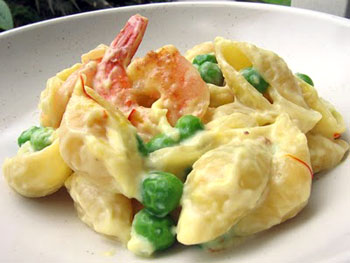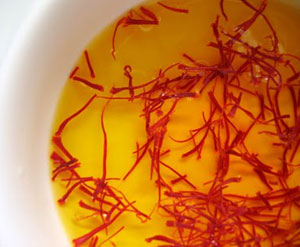 My mom says I have expensive taste. You wouldn’t know it by the stores I go to, such as Marshall’s and Loehmann's. Yet, when it comes to eating, I like high quality foods and am more than willing to splurge.
My mom says I have expensive taste. You wouldn’t know it by the stores I go to, such as Marshall’s and Loehmann's. Yet, when it comes to eating, I like high quality foods and am more than willing to splurge.
That’s why I didn’t hesitate to buy saffron. Well, that’s not really true. I did hesitate. Not because of the price; because I have an uneasy relationship with saffron. It’s sort of like kissing someone, and the "wow" factor just isn’t there. You know, he’s a nice guy, but there aren’t any fireworks. So, you give him another try, and it’s great. Then the next time it's only so-so. You know what I mean? That’s been my experience with saffron. (Not with guys; Jeff has always been a great kisser).
I’m unequivocal when it comes to food – when I don't like something, I don't usually try it again. Which is why I’m surprised about my willingness to give saffron another chance. When I first tasted it in a great Indian restaurant, I found its floral overtones unpalatable. I thought I would be put off saffron forever after that. However, another delicious Indian restaurant redeemed saffron for me by serving it in a lovely rice and pea dish. Since then, I've had it in Spanish and Middle Eastern dishes and have begun cooking with it (to mixed results). Yet, the recipe I share today is a keeper. And coming from me, that is high praise.
Given my ambivalence toward saffron, I decided to do a little research. Saffron has been cultivated for over 3000-4000 years. It is used throughout the world, most notably in Asian, Indian, Arab, Spanish, and Moroccan cuisines and can be found in both savory and sweet dishes as well as drinks.
 Saffron is extraordinarily expensive at $1000 a pound. (No, I didn’t make a mistake with the zeros). Why so pricey? Because saffron is manually picked from the stigmas of the crocus flower. It is incredibly labor and time intensive, as a result. Additionally, it takes a football field’s worth of saffron threads to make just 1 pound! Fortunately, only a tiny amount is needed for most recipes, so you don’t need a second mortgage on your house to cook with it.
Saffron is extraordinarily expensive at $1000 a pound. (No, I didn’t make a mistake with the zeros). Why so pricey? Because saffron is manually picked from the stigmas of the crocus flower. It is incredibly labor and time intensive, as a result. Additionally, it takes a football field’s worth of saffron threads to make just 1 pound! Fortunately, only a tiny amount is needed for most recipes, so you don’t need a second mortgage on your house to cook with it.
Most chefs and home cooks alike recommend using saffron threads instead of powder to ensure that you are receiving true saffron and superior flavor. The threads should be soaked in water prior to using in the recipe, and suggested soaking times range from 20 minutes to several hours. I soaked mine for 2 hours.
In this recipe, the saffron was fragrant (not overpoweringly so) and slightly smoky. I loved it in the creamy sauce, which was satisfying yet not too rich. For a vegetarian version, simply omit the shrimp, which is how I ate it.
I also recommend using fresh English peas. Just look at these perfectly round, shiny peas nestled together. They are sweet-natured and delicate and should be treated with care. That’s why I add them at the end of the cooking process. The heat from the sauce cooks them enough; overcooking peas not only makes them mushy but also depletes them of their nutrients, including Vitamins C and K.
Pasta Shells in Creamy Saffron Sauce with Shrimp and Fresh Peas
8 ounces pasta shells
1 teaspoon saffron threads
3 teaspoons water
2 shallots, thinly sliced
2 tablespoons butter
2 cups milk (whole or low-fat)
2 tablespoons flour
2 tablespoons dry white wine
2 cups fresh shelled English peas
Salt and pepper, to taste
2-3 tablespoons olive oil
24-28 extra large or jumbo shrimp
Cook pasta in salted water according to instructions.
Place 1 tsp saffron threads in a small bowl with 3 tsp water, and let rest for a minimum of 2 hours; the threads will swell in size. If you don’t have the time, then use this quick soak method. When you are ready to add the saffron to the sauce, just drain the water, but don’t crush the threads. Since saffron is intensely flavored, I suggest adding just a few threads at time and tasting as you go until you get the desired amount.
In a medium saucepan, over medium heat, melt butter. Add shallots, and sauté 2-3 minutes, or until softened. Add milk and flour, and stir until well combined and sauce begins to thicken and bubble. (I used low-fat milk, but whole milk’s added fat would make an even creamier consistency). Add white wine and a pinch of the prepared saffron threads. Add the fresh shelled peas to the sauce, and cook for 1-2 minutes. Season generously with salt and pepper.
Heat olive oil in a large skillet over medium-high heat. Add the shrimp, and sauté for 5-7 minutes, turning to ensure that they brown evenly on both sides.
Add the cooked pasta and shrimp to the saffron sauce, and toss well to coat. Gently heat through, and serve immediately. Makes 4 servings.
Susan Russo is a free lance food writer in San Diego, California. She publishes stories, recipes, and photos on her cooking blog, <Food Blogga and is a regular contributor to NPR’s <Kitchen Window. She is also the author of two upcoming books that will be published in the fall of 2010.

